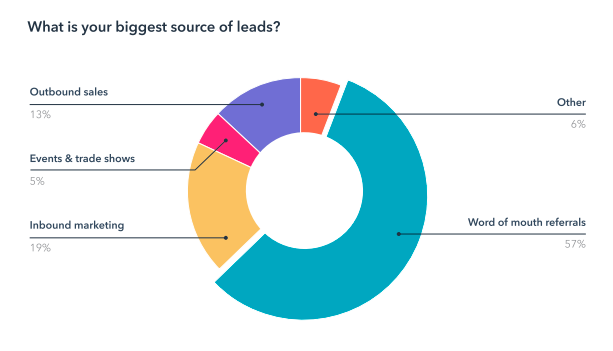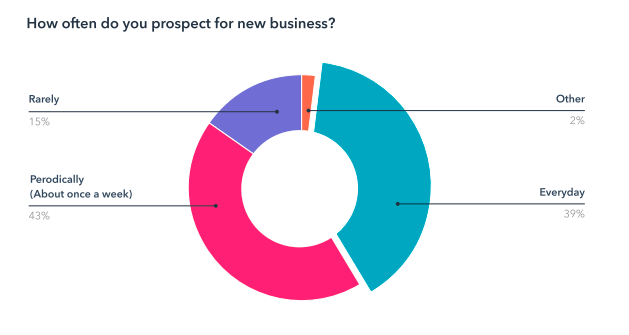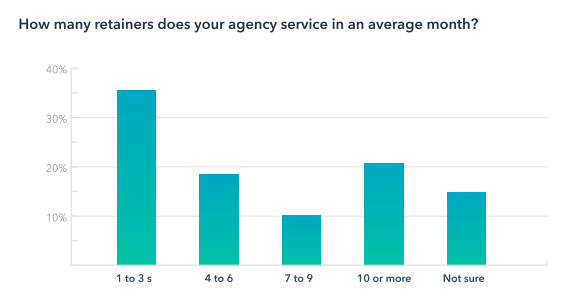In our 2018 Agency Growth Report, we found that winning new clients was an agency’s biggest pain point. This year we wanted to dive deeper into this topic and learn more about how agencies approach their sales processes.
Last Thursday, we launched the ![]() This 30-page report is jam-packed with data-driven research from over 1,400 agencies worldwide. And, we learned some pretty surprising things about how agencies win new business. Here’s a sneak peek for you, but go ahead and
This 30-page report is jam-packed with data-driven research from over 1,400 agencies worldwide. And, we learned some pretty surprising things about how agencies win new business. Here’s a sneak peek for you, but go ahead and ![]()
First: 57% of agencies get new leads from referrals.

The way that customers and clients discover new companies has undergone a massive shift in the last decade. A few years ago, the main way a potential client heard about you was by finding you online. They would read a few blog posts, visit your website, download some of your content, and eventually make the jump to engage with sales. This sequence of events has typically been the norm.
Today, that’s no longer the case.
Now more than ever, prospective customers and clients are looking to their peers for recommendations and referrals. The word of a company, its marketing team, and its sales reps is no longer reigning supreme. In 2019 and beyond, word of mouth is king for driving new leads to your business.
This shift affects agencies just as much, if not more than other types of businesses.
As word of mouth becomes more important for businesses everywhere, agencies must adapt their business strategies to ensure that they can generate quality leads, build trust with their prospects and clients, and ultimately win more new business.
Second: 77% of agencies prospect to find new leads, and nearly half prospect at least once a week.

Prospecting is the first step of the sales process at a majority of businesses, including agencies. The above statistic shows us two things. First, even if you are getting consistent high-quality referrals, agencies still need to prospect to reach new clients. And second, that having an effective inbound marketing strategy (from word of mouth referrals, driving organic traffic with your content, building up a social presence, and more) are invaluable for growth.
Think about what your agency could look like if the time spent dedicated to prospecting was instead spent upselling current clients and expanding your contracts.
When was the last time you took a step back and evaluated your agency’s strategies for finding new business? If it’s been a while, use the rest of this quarter to reevaluate your approaches to generating new business, and ensure that you have a well-rounded, effective strategy in place.
Third: Nearly 40% of agencies service at least one to three retainers per month, with others servicing even more.

The agency model has undergone a massive shift in the last few decades.
Traditionally, everything was about project work: how many clients you could take on at once, how many campaigns you could run, and how many prospective clients you had in the pipeline to start working on once those campaigns were finished.
But with retainers, agencies sign contracts with brands like the ones mentioned earlier in this post, and can then guarantee a steady stream of work for the length of the contract. No more worrying about finding your next client or dealing with seasonal dips in project work throughout the year. More and more, agencies are adopting retainer models.
Now, switching to a full retainer model isn’t easy, and for some agencies, keeping open the possibility to take on project-based work is important. So, what does that mean for agencies like yours?
When you have the ability to work on a retainer contract basis, you can better assess the stream of work your agency will have and can make the decision to take on projects that interest you and your team as needed.
Plus, with retainers come a few things, namely: predictable revenue, deeper client relationships, and ultimately, agency growth.
Now, these aren’t the only intriguing findings in the 2019 State of Agency Selling research report. Read more in-depth into referrals, prospecting, and retainers. And, learn about how different agencies structure their sales teams, what’s included in their sales process, how they track client information, and much more. ![]()
